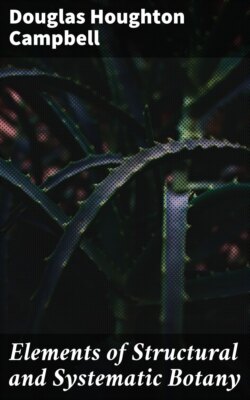Читать книгу Elements of Structural and Systematic Botany - Douglas Houghton Campbell - Страница 12
На сайте Литреса книга снята с продажи.
Class III.—Green Monads (Volvocineæ).
ОглавлениеThis group of the protophytes is unquestionably closely related to certain low animals (Monads or Flagellata), with which they are sometimes united. They are characterized by being actively motile, and are either strictly unicellular, or the cells are united by a gelatinous envelope into a colony of definite form.
Of the first group, Euglena (Fig. 9), may be selected as a type.
This organism is found frequently among other algæ, and occasionally forms a green film on stagnant water. It is sometimes regarded as a plant, sometimes as an animal, and is an elongated, somewhat worm-like cell without a definite cell wall, so that it can change its form to some extent. The protoplasm contains oval masses, which are bright green in color; but the forward pointed end of the cell is colorless, and has a little depression. At this end there is a long vibratile protoplasmic filament (c), by means of which the cell moves. There is also to be seen near this end a red speck (e) which is probably sensitive to light. A nucleus can usually be seen if the cell is first killed with an iodine solution, which often will render the flagellum (c) more evident, this being invisible while the cell is in motion. The cells multiply by division. Previous to this the flagellum is withdrawn, and a firm cell wall is formed about the cell (Fig. 9, B). The contents then divide into two or more parts, which afterwards escape as new individuals.
Fig. 10.—Volvox. A, mature colony, containing several smaller ones (x), × 50. B, Two cells showing the cilia, × 300.
Of the forms that are united in colonies[2] one of the best known is Volvox (Fig. 10). This plant is sometimes found in quiet water, where it floats on or near the surface as a dark green ball, just large enough to be seen with the naked eye. They may be kept for some time in aquaria, and will sometimes multiply rapidly, but are very susceptible to extremes of temperature, especially of heat.
The colony (Fig. 10, A) is a hollow sphere, the numerous green cells of which it is composed forming a single layer on the outside. By killing with iodine, and using a strong lens, each cell is seen to be somewhat pear-shaped (Fig. B), with the pointed end out. Attached to this end are two vibratile filaments (cilia or flagella), and the united movements of these cause the rolling motion of the whole colony. Usually a number of young colonies (Fig. x) are found within the mother colony. These arise by the repeated bipartition of a single cell, and escape finally, forming independent colonies.
Another (sexual) form of reproduction occurs, similar to that found in many higher plants; but as it only occurs at certain seasons, it is not likely to be met with by the student.
Other forms related to Volvox, and sometimes met with, are Gonium, in which there are sixteen cells, forming a flat square; Pandorina and Eudorina, with sixteen cells, forming an oval or globular colony like Volvox, but much smaller. In all of these the structure of the cells is essentially as in Volvox.
